The forgotten French developmental history of the All American M1 Garand rifle
- OR -
A funny thing happened in France on the way to develop a Main Battle Rifle.

The United States Rifle, Caliber .30, M1 aka - "M1 Garand"
The United States Rifle, Caliber .30, M1 designed by John C. Garand often with the same reverence of a god or the Titan Prometheus the giver of fire. Just as Zeus's warning to Prometheus that every gift brings a penalty - that man is happy as long as he does not gain the knowledge that can change his world.
Mr. Garand's rifle would certainly play a part in the changes in the world. How could the M1 be any less with production in the multiple millions, the M1 rifle had the highest front line infantry distribution of any issued semi-automatic rifle of the World War II.
All American military firearms collectors have all heard the story of the later development of of the M1 rifle by John Garand, his tenacity in wanting the "primer actuated" action and his quick development of the .30 caliber rifle over the earlier .276 experiments. Our question is where did all this come from, why the .276 and where do we trace the ideas and origins of the M1?
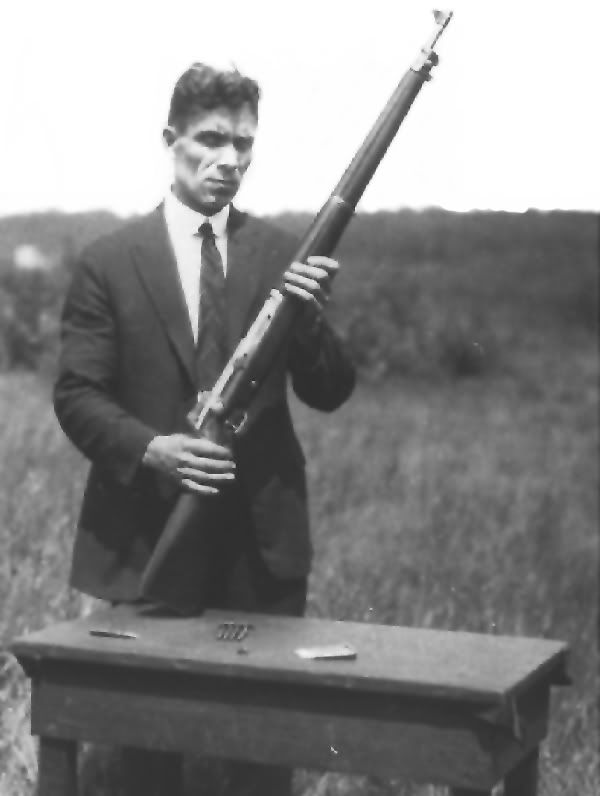
Mr. Garand with one of his prototypes (note the cocking handle and op rod).
While I was researching the development of the French MAS 49-56 rifle I came across a comment, "...the trigger group from the MAS is so similar to the M1 it must have been a development from the M1."
Because the French MAS auto-loading rifles dates of development are far too early for this to be the case I started to find connections and they start in France.

The RSC Mle.1917 French auto-loading rifle.
Where did it start? The connection starts with the then new weapon, designed by Ribeyrolle, Sutter and Chauchat, a rifle that would become the Le fusil automatique de 8 mm RSC modele 1917 or RSC Mle. 1917.
Over 80 thousand rifles of RSC Mle. 1917 were produced for the French army in 1918. France arming it's soldiers in large numbers with a self-loading rifle was a forward thinking concept at the time. The production numbers of the RSC Mle.1917 show a clear intent of France to equip many of it's infantry with the rifle and attempt to change their battlefield tactical procedures.
But we need to back up a bit and talk about Mr. Garand and the connection to the Le fusil automatique de 8 mm RSC modele 1917 or RSC Mle.1917 and Mle. 1918.
Mr. Garand was born Jean Cantius Garand born in Quebec part of a French speaking family, later Mr. Garand was to list his name in the Anglo form John. There are many articles and books focused on his famous rifle that describe some of Mr. Garand's poor childhood and his early entry into machine design. Mr. Garand's talents for mechanical devices and unusual ideas fill more than a few pages of historical reviews. I find Mr. Garand's story in many ways similar to some of the aspects of Mr. Kalashnikov and his talents. Both men seem to be tireless tinkering mechanical obsessives with a few eccentricities (a sign of creativity).
What is almost always missing is the work Mr. Garand did with Springfield Arsenal where he was involved with attempts to adapt the RSC Mle. 1918 design to the 30-06 cartridge. With this early Springfield Arsenal we now we have our direct connection from early concept rifle to the development of the United States Rifle, Caliber .30/M1.
So now we can clearly review how French rifle design had such a large impact on military rifles. The question is why is this rifle so forgotten when it clearly is so important to military self-loading rifle history?
My conclusion was that the "all American rifle" indeed had a French grandfather and a French Canadian father. Who would have guessed that M1 would have been that French in lineage. The closer you look the more connections you can make in the relationship from one rifle to the other. I would even hazard a guess that the .276 was a reaction to the problems with higher pressure cartridges and auto-loading rifles like the RSC Mle.1917, metallurgy would of course later improve negating that concern.
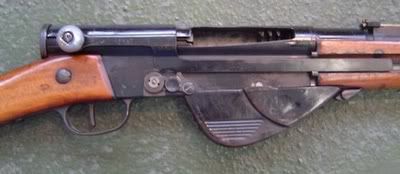
RSC Mle.1917 with bolt and op rod in the reward position.
It is like the first time you find the connection from sewing machines and gun manufacturing and strangely history becomes interesting, unlike your old boring classes in school.
Lets start with a simple review of the two rifles with photographs.
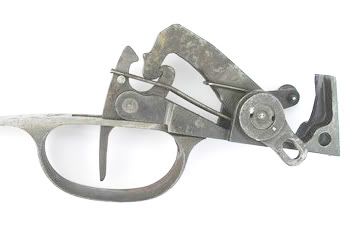
The RSC Mle. 1917 trigger group (a progression from a Browning design, used to this day in many firearms).
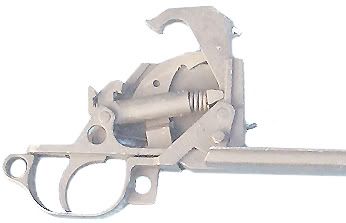
The M1 Garand trigger group (note the improvements).
As you can see from the photos there are clear indications that the US M1 and even later rifles have trigger groups that show a mechanical lineage to this rifle. The spring and detents of the RSC Mle. 1917 look a lot like same parts in the much later M16 as the mechanism of the RSC Mle. 1917 is quite simple. I thought it was noteworthy how you can see the development and the source from the RSC Mle. 1917 to the M1 Garand. For any of you interested the above also links to the Browning Auto shotgun the source for many derivative designs in trigger/hammer design.
The operating rod is so obvious that I am surprised this has not been noted more often (if at all).

RSC Mle.1917 side view with operating rod highlighted.

RSC Mle.1917 operating rod disassembled from the rifle.
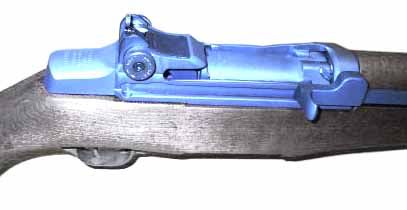
M1 Garand side view with operating rod highlighted.
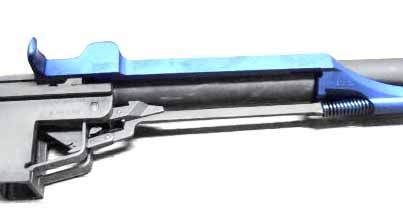
M1 Garand operating rod on a partly disassembled rifle, highlighted in blue.
The "en block" clip always catches my attention.
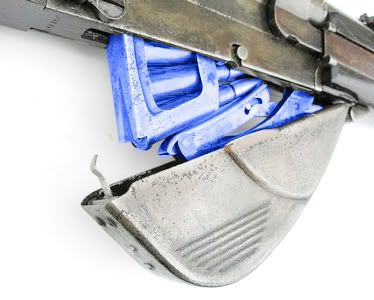
RSC Mle.1917 worm's eye side view of the "en block" clip highlighted, note that this rifle was designed to have the clip inserted from the bottom after the casing was rotated forward.
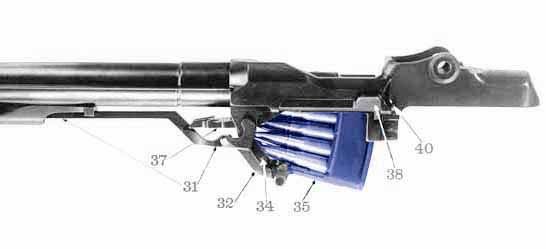
M1 Garand .276 prototype with side view of the "en block" clip highlighted in blue.
The bolt group - ahead of it's time?
Some views of the bolt group from both rifles you can clearly see the rotating mechanism and how the RSC Mle.1917 connects to it's flat op rod and how the M1 Garand has a "floating" connection slide built into the op rod.
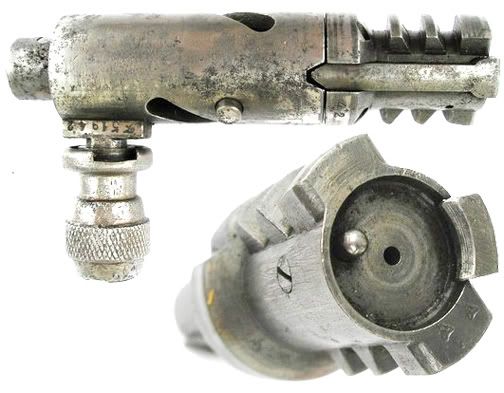
RSC Mle.1917 bolt and bolt face.
Note how the cocking handle knob threads onto a protruding shaft to connect to the op rod. Note the multiple lugs on the bolt, this complexity is one of the binding areas for contamination and fouling.
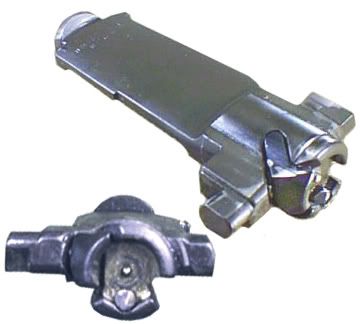
M1 rifle's bolt and bolt face.
Note the improvements over similarities from the M1 bolt and it's predecessor Garand’s improvements are many his improved op-rod and bolt are noteworthy.
Patent drawings comparing the two rifle designs.
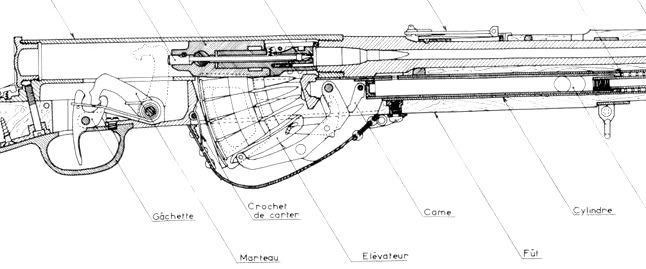
RSC Mle.1917 rifle drawing, note the relationship of the working parts.
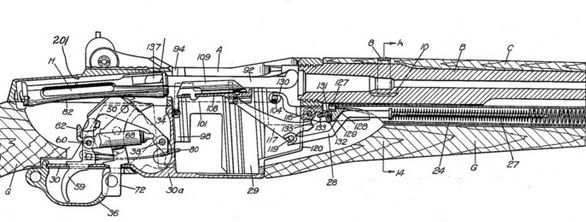
Mr. Garand's .276 prototype drawings.
While in no way a direct copy, clearly Garand’s review of the French rifle earlier in his life left a lasting impression and this system eventually developed into the Garand designed rifle. Some criticism could be leveled because there are so many other rifle designs that also did lend features, but Garand’s direct connection to the original French rifle via his employer and direct study is unmistakable.
There is no shame in admitting that “America’s Rifle” had French origins, that is unless bumper sticker patriotism and beer clouded pride is more important.
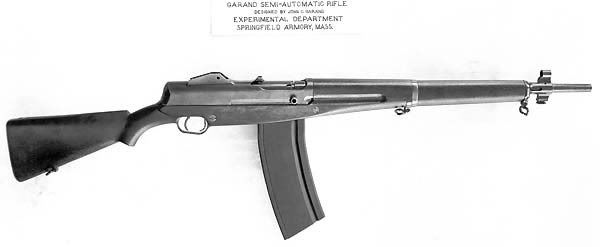
As an historical item, Mr. Garand's Springfield Arsenal magazine fed prototype rifle for consideration.
Information gathered from:
Small Arms of the World: A Basic Manual of Small Arms (12th revised edition)
By - Edward Clinton Ezell
Proud Promise
French Autoloading Rifles, 1989-1979
By - Jean Huon
The FN-49, The last elegant old-world military rifle
By - Wayne Johnson
Les fusils semi-automatiques:
Le fusil automatique de 8 mm RSC modèle 1917
Le fusil FN FAL expliqué
Par - G. Henrotin
Armes à feu de l'Armée française 1860 à 1940
Par - Jean Martin chez Crepin Leblond
L'Armement De L'Infanterie Francaise 1918-1940
éditeur - Argout - Gazette des armes
la grande aventure des fusils réglementaires français 1866-1936
éditeur - Argout - Gazette des armes
La Notice Sur Le Fusil à Répétition De 7,5 Mm. Modèle 1936
éditeur - Charles Lavauzelle & Cie
More information has popped up from the original article above.
RSC 1917 et Garand
No comments:
Post a Comment